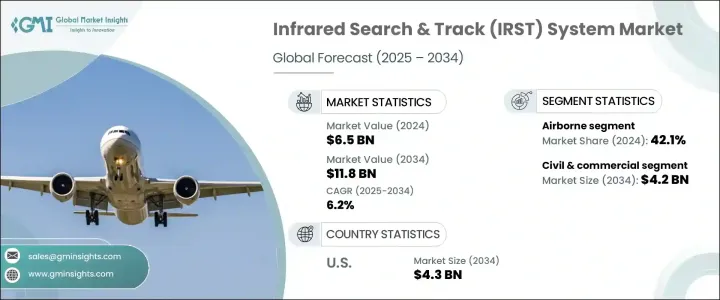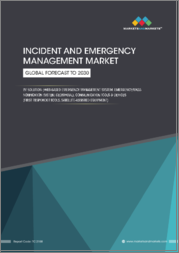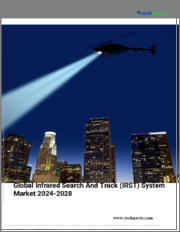
|
시장보고서
상품코드
1740747
적외선 수색 및 추적(IRST) 시스템 시장 기회, 성장 촉진요인, 산업 동향 분석, 예측(2025-2034년)Infrared Search and Track (IRST) System Market Opportunity, Growth Drivers, Industry Trend Analysis, and Forecast 2025 - 2034 |
||||||
세계 적외선 수색 및 추적(IRST) 시스템 시장은 2024년에 65억 달러로 평가되었고, CAGR 6.2%로, 2034년에는 118억 달러에 이를 것으로 추정되고 있습니다.
고급 패시브 감시 시스템에 대한 요구가 높아짐이 이 확대에 박차를 가하고 있는 중요한 요소 중 하나입니다. 기존의 레이더 기반 시스템과 달리 IRST 시스템은 적극적으로 신호를 발생시키지 않고 공중이나 해상 위협을 스텔스로 감지 및 감시할 수 있기 때문에 차세대 방어 플랫폼에 필수적인 툴이 되었습니다. 다양한 방어 활동으로 무인 플랫폼과 원격 조종 플랫폼의 중요성이 높아지는 가운데, IRST 기술의 채택은 급속히 확대되고 있습니다.

이전 정권에 의한 통상정책, 특히 트럼프 시대에 부과된 관세는 방위 및 항공우주 섹터 전체에 코스트 압력을 가져왔습니다. 이러한 추가 비용은 중요한 부품과 재료의 가격을 올렸을뿐만 아니라 제조 생태계를 혼란스럽게 만들었습니다. 결과적으로 IRST 시스템 제조업체는 조달 및 공급망 모델을 재평가하여 보다 비용 효율적이고 신뢰할 수 있는 조달 경로를 모색하고 있습니다. 세계 무역의 불확실성이라는 광범위한 환경은 일부 투자자들에게 대규모 IRST 개념에 대한 헌신을 끌어들여 특정 부문에서 기술 혁신과 배포 일정을 일시적으로 늦추는 파급 효과를 창출하고 있습니다.
| 시장 범위 | |
|---|---|
| 시작 연도 | 2024년 |
| 예측 연도 | 2025-2034년 |
| 시작 금액 | 65억 달러 |
| 예측 금액 | 118억 달러 |
| CAGR | 6.2% |
이 시장은 플랫폼별로 공군, 해군, 육군, 기타로 분류됩니다. 새로운 위협이 진화함에 따라 기존의 레이더 시스템은 특히 스텔스 기술에 대해 점점 더 큰 한계에 직면하고 있습니다.
최종 사용자별로 분석하면 시장은 군 및 방위용도와 민간 및 상업 용도로 나뉘어집니다. 기타 교통수단은 무허가 비행물체를 검출하고 공역의 보안을 강화하기 위해 IRST 기술을 점점 연구하고 있습니다.
지리적으로 미국은 북미 IRST 시장에서 중요한 위치를 차지하고 있으며, 2034년까지 43억 달러 시장 규모를 달성할 것으로 예측되고 있습니다. 경쟁국에 의한 스텔스 기술의 진보에 대응하기 위해, 미국은 유인 및 무인 양쪽의 방위 플랫폼으로 IRST 시스템에 대한 투자를 우선시하고 있습니다.
IRST 시스템 시장은 기존 방위 계약자와 신기술 기업이 혼재하여 기술 혁신에 공헌하고 있으며, 상위 5개사가 전체의 65%에서 70%의 점유율을 차지하고 있으며, 적외선 광학, 검출 알고리즘, 시스템 통합에 있어 깊은 전문 지식을 활용하고 있습니다. 우리의 주요 기업은 목표 포착, 추적 정확성 및 상황 인식을 강화하는 차세대 개발을 추진하고 있습니다.
목차
제1장 조사 방법과 범위
제2장 주요 요약
제3장 업계 인사이트
- 생태계 분석
- 트럼프 정권의 관세 분석
- 무역에 미치는 영향
- 무역량의 혼란
- 보복 조치
- 업계에 미치는 영향
- 공급측의 영향(주요 구성요소)
- 주요 원재료의 가격 변동
- 공급망 재구성
- 생산 비용에 미치는 영향
- 수요측의 영향(판매가격)
- 최종 시장에의 가격 전달
- 시장 점유율 동향
- 소비자의 반응 패턴
- 공급측의 영향(주요 구성요소)
- 영향을 받는 주요 기업
- 전략적인 업계 대응
- 공급망 재구성
- 가격 설정 및 제품 전략
- 정책관여
- 전망과 향후 검토 사항
- 무역에 미치는 영향
- 업계에 미치는 영향요인
- 성장 촉진요인
- 스텔스 위협에 대항하기 위한 수동 감시 시스템 수요 증가
- 차세대 전투기와 해군 근대화 프로그램에 대한 투자 증가
- 적외선 센서 기술과 AI 구동형 추적 기능의 급속한 진보
- 무인 항공기(UAV)와 해군 함정에서의 IRST 시스템의 채용 확대
- 지정학적 긴장이 높아지는 가운데, 세계적으로 방위 예산이 확대
- 업계의 잠재적 위험 및 과제
- 고급 IRST 시스템과 관련된 높은 개발 및 통합 비용
- 다양한 날씨와 혼잡한 환경에서 정밀도를 확보하는 기술적 과제
- 개발 및 인증 비용이 높아
- 성장 촉진요인
- 성장 가능성 분석
- 규제 상황
- 기술의 상황
- 장래 시장 동향
- 갭 분석
- Porter's Five Forces 분석
- PESTEL 분석
제4장 경쟁 구도
- 소개
- 기업의 시장 점유율 분석
- 주요 시장 기업의 경쟁 분석
- 경쟁 포지셔닝 매트릭스
- 전략 대시보드
제5장 시장 추정 및 예측 : 플랫폼별, 2021 –2034
- 주요 동향
- 공군
- 군용기
- 연습기
- 전투기
- 특수 임무용 항공기
- 무인 항공기(UAV)
- 군용기
- 해군
- 앞바다 순시선(OPV)
- 구축함
- 프리게이트함
- 양륙함
- 코르벳
- 고속 공격정(FAC)
- 순양함
- 항공모함
- 육군
- 기타
제6장 시장 추정 및 예측 : 최종 용도별, 2021 –2034
- 주요 동향
- 민간 및 상업
- 군 및 방위
제7장 시장 추정 및 예측 : 지역별, 2021 –2034
- 주요 동향
- 북미
- 미국
- 캐나다
- 유럽
- 독일
- 영국
- 프랑스
- 스페인
- 이탈리아
- 네덜란드
- 아시아태평양
- 중국
- 인도
- 호주
- 한국
- 일본
- 라틴아메리카
- 브라질
- 멕시코
- 아르헨티나
- 중동 및 아프리카
- 사우디아라비아
- 아랍에미리트(UAE)
- 남아프리카
제8장 기업 프로파일
- Aselsan AS
- Grupo Oesia
- Hanwha Systems Co.,Ltd.
- HGH Systemes Infrarouges
- Leonardo SPA
- Lockheed Martin Corporation
- Northrop Grumman Corporation
- Rheinmetall AG
- Safran SA
- Thales Group
- Tonbo Imaging Private Limited
The Global Infrared Search and Track System Market was valued at USD 6.5 billion in 2024 and is estimated to grow at a CAGR of 6.2% to reach USD 11.8 billion by 2034. The increasing need for advanced passive surveillance systems is one of the key elements fueling this expansion. Unlike traditional radar-based systems, IRST systems enable stealthy detection and monitoring of aerial and maritime threats without actively emitting signals, making them an essential tool for next-generation defense platforms. With the rising significance of unmanned and remotely piloted platforms across various defense operations, the adoption of IRST technology is expanding rapidly. Integration of these systems into both aerial and naval vehicles is transforming modern surveillance strategies and is expected to remain a key driver of market momentum in the coming years.

Trade policies from previous administrations, particularly the tariffs imposed during the Trump era, have introduced cost pressures across the defense and aerospace sectors. These added expenses have not only increased the prices of critical components and materials but have also disrupted the manufacturing ecosystem. As a result, IRST system manufacturers are reevaluating their procurement and supply chain models, seeking more cost-effective and reliable sourcing channels. The broader environment of global trade uncertainty has made some investors hesitant to commit to large-scale IRST initiatives, creating a ripple effect that temporarily slows innovation and deployment timelines in certain segments.
| Market Scope | |
|---|---|
| Start Year | 2024 |
| Forecast Year | 2025-2034 |
| Start Value | $6.5 Billion |
| Forecast Value | $11.8 Billion |
| CAGR | 6.2% |
The market is categorized by platform into airborne, naval, land, and others. In 2024, the airborne segment led the market with a 42.1% share and is projected to maintain its lead throughout the forecast period. The dominance of airborne IRST systems stems from the increasing global focus on enhancing aerial combat readiness and operational superiority. As new threats evolve, traditional radar systems are facing growing limitations, particularly against stealth technologies. The need for silent tracking, long-range detection, and precise target acquisition is prompting defense agencies to equip advanced aircraft with state-of-the-art IRST solutions.
When analyzed by end-user, the market is divided into military and defense and civil and commercial applications. The civil and commercial segment is expected to attain a market value of USD 4.2 billion by 2034. As threats to critical infrastructure and public safety grow, demand is rising for passive tracking solutions in civilian sectors. Airports and other transportation hubs are increasingly exploring IRST technologies to detect unauthorized flying objects and enhance airspace security. At the same time, industries involved in maritime operations are adopting these systems to monitor high-risk regions discreetly, leveraging passive detection capabilities that can provide early warnings without drawing attention.
Geographically, the United States holds a significant position in the North America IRST market and is forecast to achieve a market size of USD 4.3 billion by 2034. The country's focus on strategic defense development and maintaining global superiority has pushed demand for advanced surveillance systems, especially passive infrared tracking solutions. In response to advancements in stealth technologies by competing nations, the U.S. is prioritizing investment in IRST systems across both manned and unmanned defense platforms. The push to integrate these technologies into new-generation air combat programs is further strengthening the domestic market outlook.
The IRST system market is notably competitive, with a mix of established defense contractors and emerging technology firms contributing to innovation. The top five market leaders-holding between 65% to 70% of the total share-are leveraging deep expertise in infrared optics, detection algorithms, and systems integration. These key players are driving next-generation developments that enhance target acquisition, tracking accuracy, and situational awareness. To stay ahead, many companies are forming strategic partnerships within the defense supply chain, pooling resources to accelerate the development and deployment of advanced IRST capabilities.
Table of Contents
Chapter 1 Methodology and Scope
- 1.1 Market scope and definitions
- 1.2 Research design
- 1.2.1 Research Approach
- 1.2.2 Data collection methods
- 1.3 Base estimates and calculations
- 1.3.1 Base year calculation
- 1.3.2 Key trends for market estimation
- 1.4 Forecast model
- 1.5 Primary research and validation
- 1.5.1 Primary sources
- 1.5.2 Data mining sources
Chapter 2 Executive Summary
- 2.1 Industry 360° synopsis
Chapter 3 Industry Insights
- 3.1 Industry ecosystem analysis
- 3.2 Trump administration tariffs analysis
- 3.2.1 Impact on trade
- 3.2.1.1 Trade volume disruptions
- 3.2.1.2 Retaliatory measures
- 3.2.2 Impact on the industry
- 3.2.2.1 Supply-side impact (key components)
- 3.2.2.1.1 Price volatility in key materials
- 3.2.2.1.2 Supply chain restructuring
- 3.2.2.1.3 Production cost implications
- 3.2.2.2 Demand-side impact (selling price)
- 3.2.2.2.1 Price transmission to end markets
- 3.2.2.2.2 Market share dynamics
- 3.2.2.2.3 Consumer response patterns
- 3.2.2.1 Supply-side impact (key components)
- 3.2.3 Key companies impacted
- 3.2.4 Strategic industry responses
- 3.2.4.1 Supply chain reconfiguration
- 3.2.4.2 Pricing and product strategies
- 3.2.4.3 Policy engagement
- 3.2.5 Outlook and future considerations
- 3.2.1 Impact on trade
- 3.3 Industry impact forces
- 3.3.1 Growth drivers
- 3.3.1.1 Rising demand for passive surveillance systems to counter stealth threats
- 3.3.1.2 Increasing investments in next-generation fighter aircraft and naval modernization programs
- 3.3.1.3 Rapid advancements in infrared sensor technology and AI-driven tracking capabilities
- 3.3.1.4 Growing adoption of IRST systems across unmanned aerial vehicles (UAVs) and naval vessels
- 3.3.1.5 Expansion of defense budgets globally amid heightened geopolitical tensions
- 3.3.2 Industry pitfalls and challenges
- 3.3.2.1 High development and integration costs associated with advanced IRST systems
- 3.3.2.2 Technical challenges in ensuring accuracy across diverse weather and cluttered environments
- 3.3.2.3 High development and certification costs
- 3.3.1 Growth drivers
- 3.4 Growth potential analysis
- 3.5 Regulatory landscape
- 3.6 Technology landscape
- 3.7 Future market trends
- 3.8 Gap analysis
- 3.9 Porter's analysis
- 3.10 PESTEL analysis
Chapter 4 Competitive Landscape, 2024
- 4.1 Introduction
- 4.2 Company market share analysis
- 4.3 Competitive analysis of major market players
- 4.4 Competitive positioning matrix
- 4.5 Strategy dashboard
Chapter 5 Market Estimates and Forecast, By Platform, 2021 – 2034 ($ Mn)
- 5.1 Key trends
- 5.2 Airborne
- 5.2.1 Military aircraft
- 5.2.1.1 Trainer aircraft
- 5.2.1.2 Combat aircraft
- 5.2.1.3 Special mission aircraft
- 5.2.2 Unmanned aerial vehicle (UAV)
- 5.2.1 Military aircraft
- 5.3 Naval
- 5.3.1 Offshore patrol vessel (OPV)
- 5.3.2 Destroyers
- 5.3.3 Frigates
- 5.3.4 Amphibious warships
- 5.3.5 Corvettes
- 5.3.6 Fast attack craft (FAC)
- 5.3.7 Cruisers
- 5.3.8 Aircraft carriers
- 5.4 Land
- 5.5 Others
Chapter 6 Market Estimates and Forecast, By End Use, 2021 – 2034 ($ Mn)
- 6.1 Key trends
- 6.2 Civil & commercial
- 6.3 Military & defense
Chapter 7 Market Estimates and Forecast, By Region, 2021 – 2034 ($ Mn)
- 7.1 Key trends
- 7.2 North America
- 7.2.1 U.S.
- 7.2.2 Canada
- 7.3 Europe
- 7.3.1 Germany
- 7.3.2 UK
- 7.3.3 France
- 7.3.4 Spain
- 7.3.5 Italy
- 7.3.6 Netherlands
- 7.4 Asia Pacific
- 7.4.1 China
- 7.4.2 India
- 7.4.3 Australia
- 7.4.4 South Korea
- 7.4.5 Japan
- 7.5 Latin America
- 7.5.1 Brazil
- 7.5.2 Mexico
- 7.5.3 Argentina
- 7.6 Middle East and Africa
- 7.6.1 Saudi Arabia
- 7.6.2 U.A.E.
- 7.6.3 South Africa
Chapter 8 Company Profiles
- 8.1 Aselsan A.S.
- 8.2 Grupo Oesia
- 8.3 Hanwha Systems Co., Ltd.
- 8.4 HGH Systemes Infrarouges
- 8.5 Leonardo S.P.A.
- 8.6 Lockheed Martin Corporation
- 8.7 Northrop Grumman Corporation
- 8.8 Rheinmetall AG
- 8.9 Safran S.A.
- 8.10 Thales Group
- 8.11 Tonbo Imaging Private Limited
















